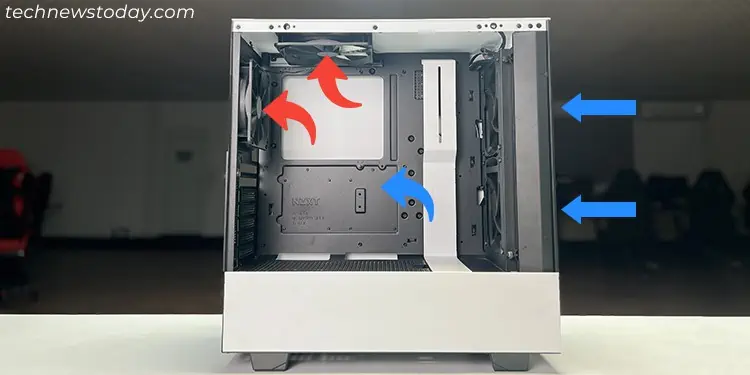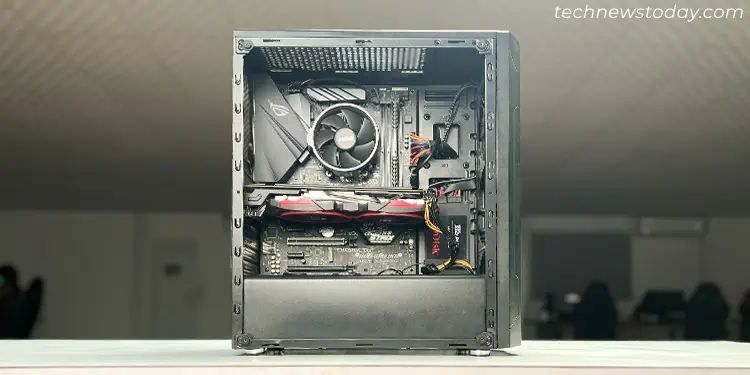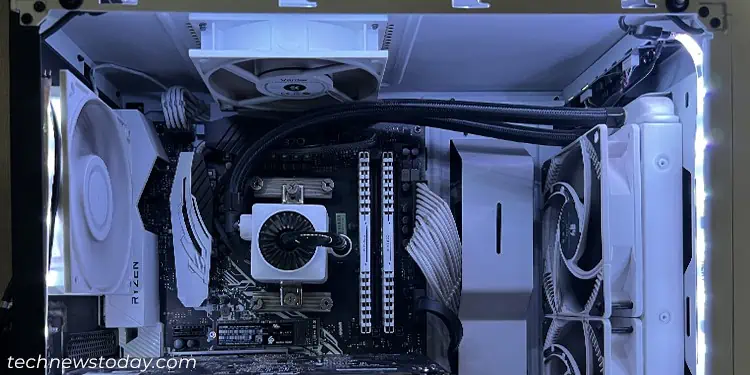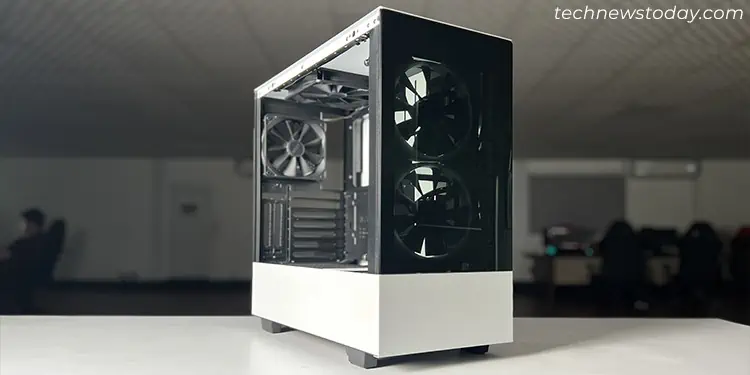When building a PC, installing the right number of case fans is crucial for proper cooling and airflow. The ideal configuration depends on case size, components, and desired internal pressure. My first PC had only a single exhaust fan, causing GPU throttling under load. After adding two front intake fans, temperatures normalized.
Since then I’ve assembled countless builds in cases of all sizes. According to my experience, it’s better if you have the following numbers of intake and exhaust fans depending on your case and motherboard size.

This is only a rough estimate, and you have to take various other factors into account to figure out the exact number you’ll need.
Factors that Affect the Number of Case Fans
The case fans must fit on your PC and provide the best cooling performance with the least possible noise. You need to consider several factors to be able to set up the perfect cooling system on your PC.
Airflow and Static Pressure
The cooling efficiency of a case fan further depends on two parameters— Airflow and Static Pressure.Airflowis the volume of air that the fan can push every time whereasstatic pressurerepresents how well the fan can push air against resistance.
You have to maintain airflow such that cool air from outside the PC gets to your PC components. Then, after these components heat up the air, the hot air goes out of your PC case. So you need to use intake fans to take in the cool air and exhaust fans to throw out the warm air.

You also need to figure out the number of intake and exhaust fans depending on what type of air pressure you want to create inside the fan. You will have toorient them in a proper directionwhile installing them.
Different case fans come with different specifications, such as fan size, RPM, and so on. These specifications determine the airflow and static pressure of air through the fans.Larger fansgenerally providehigher airflowwhilesmaller onesgenerate morestatic pressure.

Case Size and Motherboard Layout
The form factor of your PC case, motherboard layout, and available clearance due to PC components will also determine how efficient each case fan is. So you need to consider them while picking the number and placement of the fans.
Noise
Having a lot of case fans will produce more noise. So you’ll need to balance the number of fans to find a suitablemiddle point between cooling efficiency and noise level. On the other hand, using many fans may allow you todecrease their speedto lower RPM and quieten the overall setup.
You can also usequieter fan designswith lower RPM from the get-go. It’s better to use PWM fans instead of DC ones as well since they are usually quieter.

Also, since the mounting surface on the different panels is not the same,installing the fanson one side may produce more noise than another. you’re able to install the fans on theareas that make the least noisewhile maintaining a proper airflow direction.
Most CPU air coolers actuallymake more noisecompared to case fans. So you can alsoinstall a liquid coolerto make your setup overall quieter. It will also allow you to reduce the number or speed of the case fans, thereby quieting your PC even further.
Type of CPU/GPU Cooler
The CPU and the GPU generate the most heat on your system, so you need to maintain their temperature the most. Most CPU/GPU coolers need proper case airflow to work properly, so you need to set up your case fans accordingly.
Ambient Temperature
If you work in awarmer location, the base temperature of your system will be high from the start. It will add to theoverall temperature your CPU, GPU and other components can reach. So you need to usemore case fansin such locations.
On the flip side, you might be able to decrease the number of case fans for colder locations.
Workload
Whenever you run resource-intensive tasks,your CPUand/orGPU usageincreases, consequently producing more heat. So if yourusual workload is high, you need to usemore case fansto maintain their temperature. You will also need a several case fans if you areoverclocking your CPUor GPU.
Even during normal workloads, the CPU/GPU usage can spike up in bursts. Even with a suitable CPU/GPU temperature(let’s say 50°), it can reach a high value and cause temporary thermal throttling.
So it’s best to have enough case fans to keep these processors at a lower temperature (around 40°) even during less-intensive workloads.
Efficient Fan Configuration
Now that you understand what factors you need to pay attention to, you should already have an idea of how many fans you want to choose.
Here, I’ve listed some of the efficient fan configurations I have used to help you get started. As you’ll see, I particularly like setting up slight positive air pressure. A small difference of temperature is not enough to justify the dust build up in my opinion.
But first, let’s take a brief look at how different the fans on individual panels are so that you have more information on how you should place the fans.
1/2 Front and 1 Back
Using 1 or 2 fans at the front and 1 at the back is a good starting configuration if you have asmall or mini-size case. If you have a dedicated GPU, it’s better to use 2 fans at the front. Otherwise, you can stick with 1 fan.
2 Front, 1 Back and 1 Top
It is the preferred setup for mostmid-sizecases. It works best if you have high-quality coolers for the CPU and the GPU. However, you may also use this configuration for a comparatively lower-end system on mid-size rigs.
You can also controlthe fan speedto provide lower noise during normal workload, as four fans will maintain the heat levels more efficiently.
2 Front, 1 Bottom, 1 Back, 1/2 Top
If you have ahigh-end system on a mid-sized case, it’s best to have fans on all sides. However, make sure that the bottom fan lies away from the power supply.
Also, while I recommend having 2 fans on the front, you may choose to use only one fan on the top if you use a good CPU cooler.
3 Front, 1/2 Bottom, 1 Back, 1/2 Top
For alarger case, it’s best to maintain a sufficient airflow with 3 fans out front, 2 at the bottom, 2 at the top and 1 at the back. If you want to minimize the noise, you’re able to also use only one fan at the bottom and the top.
If your PC case comes with fan slots on the side panel, you’re able to use those for the liquid cooler’s radiators. Or you canmount the radiatorsat the front andinstall the case fanson the side.